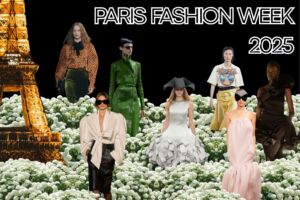
Last week, we were in Milan, where the air carried that signature metropolitan glamour, sharp tailoring, bold silhouettes, and a kind of optimism only the Italian fashion scene can conjure. But then we arrived in Paris, hoping for that ace up the sleeve: what would the new (and not-so-new) creative directors unveil this time?
And Paris, as ever, did not disappoint. Not only because of the season’s highly anticipated debuts, but because of that unique cultural and theatrical ecosystem the French capital alone can sustain. Between Piccioli, Michele, and Anderson, there was plenty to decode. Yet, it would be shortsighted to overlook the broader excellence of this Paris Fashion Week, from Schiaparelli, which continues to transform every seam into sculpture, to Saint Laurent with its razor-sharp silhouettes shimmering beneath the Eiffel Tower. Louis Vuitton redefined global luxury once again, while Paco Rabanne and Tom Ford delivered unapologetically bold, sensual visions.
Pierpaolo Piccioli at Balenciaga: lightness as philosophy
Piccioli’s debut at Balenciaga is no ordinary “passing of the torch,” but a near-surgical act, part fashion, part archaeology. Instead of shaking the archives like a snow globe (as so many do when inspiration wanes), he approaches them with quiet precision. He doesn’t imitate Cristóbal Balenciaga, by now cited more often than a saint, but seeks to understand his breath. What he discovers is almost poetic: between fabric and body, there was air. Revolutionary in 1957, and perhaps even more so today, in an era when clothes cling to us like mortgages or algorithms. Piccioli doesn’t merely offer an aesthetic, he presents a methodology. He speaks of lightness, of volume without weight, and introduces pieces that are arguments in themselves: a coat with a back slit, a triangular cape, a 3D floral knit. These are not garments; they’re essays in form. In an age that demands everything be “user-friendly,” Piccioli reclaims the right to complexity, and with that, the right to think.
Alessandro Michele at Valentino: the return of the fireflies
Then there’s Alessandro Michele at Valentino, who reconnects not with the archive (too simple), but with the fireflies. Yes, those Pasolini fireflies, “fluttering with amorous flights and lights.” Michele doesn’t just design clothes; he seeks to see in the dark. He suggests the fireflies aren’t gone, we’ve simply forgotten how to notice them. A message, perhaps, to all of us in fashion and media: disarm your gaze, and learn to see anew. On the runway, the mood was poetic nostalgia rendered with precision: pink satin jackets, glittering shorts, sharply tailored suits with stirrups, gold-thread cardigans. It looks 1970s, but it’s really 2026, a new era learning to reuse the best metaphors. Michele mines the past not for validation, but for emotion.
Jonathan Anderson at Dior: Quiet Reformulation
And then came Dior, with Jonathan Anderson’s long-awaited debut for womenswear. He arrived through the front door, elegant, deliberate, and fully aware of the stakes. After all, Dior isn’t just a brand; it’s a national treasure, the house of the New Look, the Bar jacket, and the corolla silhouette. A sacred terrain. But Anderson, trained in tension through JW Anderson and Loewe, doesn’t demolish; he reformulates. He layers couture with casual, satin with denim, heritage bustiers with city shorts, creating a dialogue between past and present. Some expected shock value; instead, he offered quiet modernity. He even reintroduced the 1946 logo, the solid “D” followed by slanted lowercase letters, a reminder that not all heritage requires erasure. Anderson’s collection breathes like open-source code, proof that legacy can evolve without losing its essence.
Fashion’s new grammar
As Elisabeth Paton notes, fashion’s language is changing. Dior, under Anderson, becomes a case study in new syntax: no glossy nostalgia, no forced futurism, but a subtle narrative built from familiar symbols used to say something new.
It sounds effortless, it isn’t.
This season tells us something essential: designers are no longer trying to dazzle; they’re trying to communicate. Fashion doesn’t crave spectacle; it seeks understanding. It’s no longer about silencing the audience, but about inviting conversation, nuanced, layered, occasionally uncomfortable.
And one thing remains certain: the fireflies aren’t dead.
We simply have to look harder, perhaps in a petal-cut bermuda, a perfectly pressed jacquard jacket, or a Dior bustier quietly stepping into the future.






